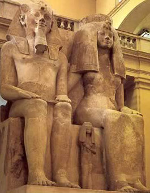|
Archaeologists Find 3,400-year-old 'Lost City' in Egypt
April 12, 2021
Egypt has announced the discovery of what officials say is the largest ancient city ever found in the country. The 3,400-year-old city, termed the "The Rise of Aten," dates to the reign of Amenhotep III. Well-known archaeologist and former antiquities minister Zahi Hawass said that the city is near Luxor and the famed Valley of the Kings, the final resting place of so many of Egypt's pharaohs. Some of the walls found were 9 feet tall. Among the curious finds was a set of walls that enclosed a residential and administrative area in a zigzag fashion. Officials said that the bulk of the city remained to be unearthed. Teams digging at the site, between temples of Amenhotep III and Ramses III, have found mud bricks bearing Amenhotep III's seal, providing evidence for the age of the city. Teams found the remains of a bakery, including ovens, tools, and storage vessels; a glass-blowing kiln; and a workshop, filled with tools used for spinning and weaving. Also found were amulets bearing images of scarab beetles, many other pieces of jewelry, a large number of tools used in daily life, and a great many pieces of pottery. Amenhotep III is far and away the pharaoh of whom the most statues survive. Archaeologists have found more than 250. He is perhaps most well-known among statuary circles for the Colossi of Memnon (right), Amenhotep III ruled Egypt from 1391 B.C. to 1353 B.C. His son took the throne as Amenhotep IV but later changed his name to Akhenaten and created a new royal city, Akhetaten, later known as Amarna, in doing so abandoning the city just unearthed, which Hawass also termed "the Lost Golden City." The city's use extended into further rulers, including the famous Tutankhamen and his successor, Ay. Excavations at the site began in September 2020. Archaeologists had been looking for Tutankhamen's mortuary temple. |
|
Social Studies for Kids
copyright 2002–2024
David White





 two giant statues that depict him and Queen Tiy.
two giant statues that depict him and Queen Tiy.
